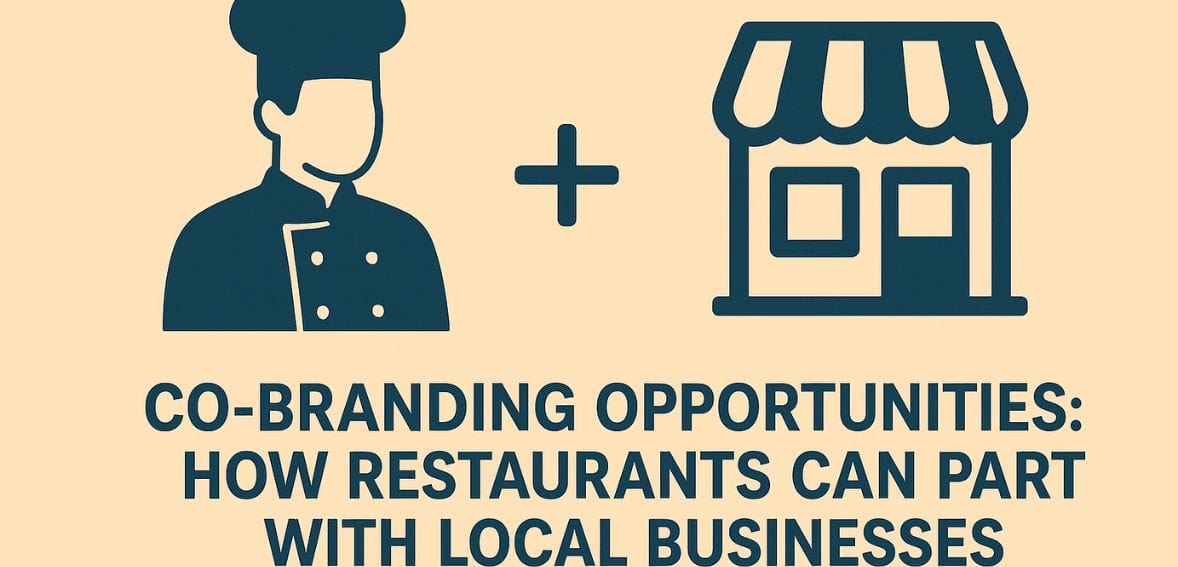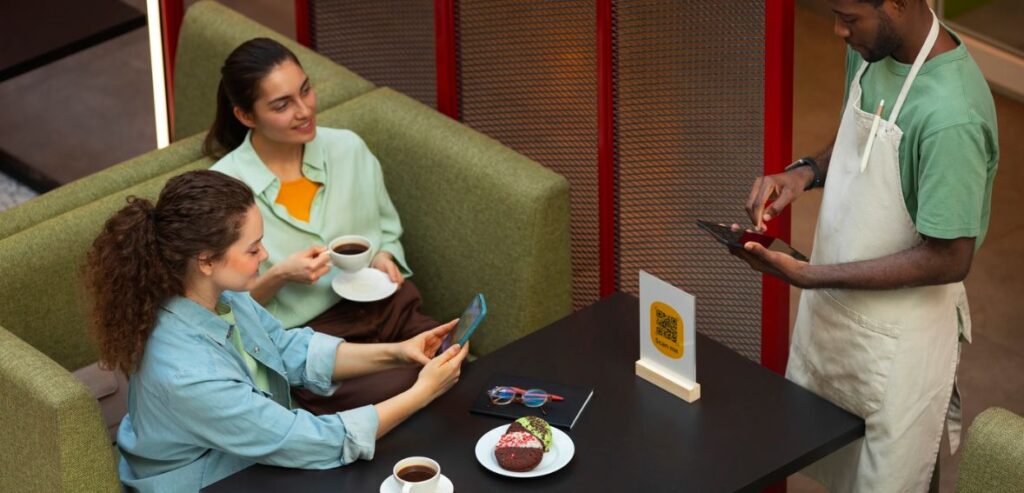
Co-Branding Opportunities: How Restaurants Can Partner With Local Businesses
Restaurants face the twin challenges of differentiating themselves from fierce competition and preserving meaningful relationships with their communities in the ever-changing world of dining and consumer preferences. Consumers today are looking for experiences that feel genuine, interesting, and anchored in their local culture rather than just a plate of food or a speedy transaction.
This change has made room for innovative approaches that go beyond conventional marketing or advertising. Co-branding is one such tactic that has become more popular recently, in which eateries work with nearby companies to establish profitable alliances.
Co-Branding Opportunities are much more than just cross-promotional campaigns; they are the combining of two identities to provide value that neither could provide on its own. When done well, these partnerships can draw attention, increase brand loyalty, and give consumers new experiences.
Co-branding with nearby companies offers restaurants, which frequently serve as social hubs in their communities, a chance to improve their relationship with the communities they serve, in addition to gaining a marketing edge. The options are almost limitless, ranging from bakeries partnering with local breweries to upscale restaurants working with nearby farms.
Co-branding is particularly effective in the restaurant business because it connects ordinary dining experiences to a larger story. A meal transforms into more than just food; it becomes a narrative about support for local businesses, community, and shared values. When restaurants try to showcase local artisans, service providers, or merchants, patrons take notice. It shows that the establishment cares about people more than it does about making money.
The Value of Local Synergy

Understanding how closely food is linked to cultural identity and the community is crucial to understanding why co-branding is so successful for eateries. Dining is inherently relational, in contrast to many goods or services that could come across as impersonal or remote. People visit restaurants to celebrate, connect, and have a unique experience in addition to sating their hunger.
A restaurant gives a customer’s visit more significance when it partners with a local business. This strengthens the feeling of a common community identity by connecting the food on the table or the beverage in the glass to another company they may be familiar with or wish to check out.
The restaurant gains from this in two ways: it becomes more visible to new audiences and gains more credibility with its current customer base. Collaborating with a well-known local company can serve as a kind of recommendation, indicating reliability and sincerity.
In a similar vein, the restaurant’s customers are exposed to the partner company, resulting in a positive feedback loop. Through this type of partnership, both companies can access each other’s devoted clientele and expand their marketing reach beyond their own constrained reach.
Types of Restaurant Co-Branding Collaborations

Although co-branding is a general idea, restaurants can use it in ways that are specific to their business. Restaurants and regional food producers often form unique co-branding partnerships. For instance, featuring artisanal cheeses from a nearby dairy or showcasing produce from local farms strengthens supplier ties. Understanding effective supplier relationships ensures these collaborations are built on trust and mutual value.
Similar to this, a pizzeria might collaborate with a nearby dairy to highlight artisanal cheeses, or a café might collaborate with a local roaster to develop a special coffee blend. In addition to bolstering regional supply chains, these partnerships give eateries engaging narratives to share with patrons.
In order to create distinctive experiences, restaurants can work with companies in unrelated industries in addition to food suppliers. A beer-and-book event could be organized by a bookstore and a brewery. To add cultural depth to the dining experience, a fine dining establishment could collaborate with a nearby art gallery to showcase local artists’ creations inside the dining area.
Even service-oriented partnerships, like those with nearby fitness centers, music schools, or florists, can result in innovative, co-branded experiences that appeal to a variety of audiences. Another way to co-brand is through seasonal partnerships. Restaurants can collaborate with nearby companies to create themed offerings during holidays, festivals, or community gatherings.
For limited-edition desserts at a summer festival, a restaurant might collaborate with a nearby ice cream manufacturer; for the winter holidays, local wineries or chocolatiers might create co-branded gift baskets. These unique partnerships give customers something fresh and exciting to anticipate in addition to generating buzz.
Expanding Reach Through Shared Audiences
The capacity of co-branding to increase reach without appreciably raising marketing expenses is another significant advantage. When two companies work together, they can access each other’s customer base. This exposes eateries to new customers who might not have otherwise found them.
An author reading accompanied by themed appetizers and beverages could be the outcome of a collaboration between a local bookstore and a restaurant, for example. The restaurant’s customers learn about the bookstore, and the bookstore’s customers learn about the restaurant. Customers feel rewarded with an enhanced experience, and both businesses experience increased visibility.
This type of collaboration works especially well for small and mid-sized restaurants that lack the advertising budgets of larger chains. Instead of competing with deep-pocketed brands, they can leverage relationships to reach more people in authentic, cost-effective ways.
The Importance of Shared Marketing Efforts

Shared marketing is a key component of successful co-branding. Events, social media campaigns, and joint promotions all contribute to the partnership’s increased impact. By using each other’s channels for cross-promotion, restaurants and their partners can increase exposure and interaction.
For example, a restaurant and a craft brewery collaborating on a limited-edition beer-and-food pairing might post behind-the-scenes videos, chef and brewer interviews, and images of the creative process. Consumers watch the partnership develop in addition to the finished product. Customers’ emotional investment is strengthened by this openness and storytelling, which enhances the dining experience even before they enter the restaurant.
Challenges to Consider in Co-Branding
Co-branding has many benefits, but there are drawbacks as well that need to be carefully considered. Not every partnership will be successful, and some might even backfire if not handled carefully. Making sure that both businesses gain equally is one of the main obstacles. The relationship may suffer from resentment or imbalance if one partner seems to benefit much more from the partnership. In a similar vein, it’s critical to communicate clearly to prevent misconceptions regarding roles, expenses, and branding choices.
Another challenge lies in protecting brand identity. Restaurants must ensure that their values and reputation are not compromised by their partner. For example, a restaurant known for sustainability would face criticism if it partnered with a business that ignored environmental responsibility. Therefore, careful vetting and alignment are crucial.
Payment Transparency as a Foundation of Trust
One of the most overlooked aspects of gaining customers’ trust is being transparent about payment procedures. Customers feel appreciated and respected when they understand exactly what they are paying for, free of any ambiguous or hidden costs. The checkout page or point-of-sale system, where prices, taxes, and fees are presented clearly, is where payment clarity begins. Choosing the right restaurant POS system ensures smooth transactions and builds customer trust.
Consumers are more likely to return if they don’t have to question a charge. Being honest about expenses can mean the difference between a one-time sale and a devoted, repeat client, especially for small businesses. Transparency in payments conveys a powerful message: this company values integrity just as much as it values revenue.
Digital Wallets and the Psychology of Convenience

The popularity of digital wallets serves as an example of how customer loyalty is directly impacted by convenience. Customers frequently select companies that accept Apple Pay, Google Wallet, or comparable payment methods over those that do not. Digital wallets provide a sense of modernity and security in addition to speed.
Consumers connect companies that use these strategies with creativity and customer-focused thinking. This psychological connection is strong for recurring business. When payments are made quickly and easily, a customer will remember the good experience and be more likely to come back.
However, requiring clients to use antiquated or slower procedures runs the risk of frustrating them. Businesses can meet speed expectations and build the trust that fosters enduring loyalty by implementing digital wallets.
Long-Term Value of Restaurant Co-Branding
When co-branding develops into enduring relationships, it adds value over time in addition to instant visibility and buzz. Restaurants can establish a reputation for innovation, dependability, and community involvement by forming steady partnerships over time.
When partnerships are part of a continuous effort to support local businesses rather than being one-time occurrences, customers notice. These long-term alliances frequently result in innovative opportunities like co-branded goods, seasonal partnerships, or regular community gatherings. They eventually become a part of the restaurant’s character.
Conclusion: Building a Community Through Co-Branding
More than just marketing benefits, co-branding opportunities give restaurants a means of establishing sincere relationships with their local communities. Restaurants can celebrate local identity, create experiences that deeply connect with patrons, and meaningfully broaden their reach by collaborating with nearby companies.
For these collaborations to be successful, balance, authenticity, and shared values are crucial. A simple meal can become a narrative, a moment spent together, and a celebration of community spirit when co-branding is executed correctly. By adopting this strategy, restaurants present themselves as essential components of the communities they serve, not just as places to eat.
By integrating restaurants more deeply into the lives of their customers, co-branding gives them a sustainable advantage in a market where competition is intense and trends shift swiftly.